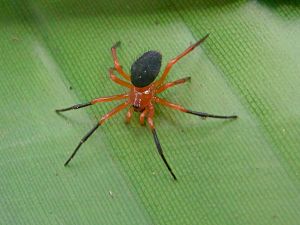Red and black Spider facts for kids
Quick facts for kids Red and black Spider |
|
|---|---|
 |
|
| In a garden at Chatswood West, Australia | |
| Scientific classification | |
| Synonyms | |
|
The red and black spider, also known as Nicodamus peregrinus, is a common spider found in eastern and southern Australia. Even though it has bright red colors, it's not considered dangerous to humans, unlike the redback spider. These spiders mostly eat small insects. You can find them in places like Queensland, New South Wales, Victoria, Tasmania, and South Australia.
Appearance and Home
These spiders usually live under tree bark, fallen logs, or stones close to the ground. Their legs are a mix of red and black. The front part of their body, called the cephalothorax (which is like their head and chest combined), is red. Their abdomen, the back part of their body, is black or sometimes a dark blue.
The small feelers near their mouth, called palps, are also red and black. Male spiders are about 8 to 10 millimeters long. Females are a bit bigger, measuring 12 to 14 millimeters.
Egg Sacs and Reproduction
Female red and black spiders lay their eggs in a special egg sac. This sac is usually 10 to 20 millimeters wide. It holds about 30 to 50 cream-colored eggs, each about 1 millimeter across.
The egg sac is flat on one side and rounded on the other, like a button. It's made of soft, white silk. The spider places these sacs in safe spots, often under bark, to protect the eggs. When kept in captivity, these spiders have been seen to mate often.
Males have an interesting way of moving. They tend to wave their front legs in the air as they walk. They also tap the ground with their palps.
Spider Names and History
This spider belongs to a group of spiders called the Nicodamidae family. Over time, scientists have sometimes placed it in other spider families, like the Theridiidae, Agelenidae, and Zodariidae families.
The red and black spider was first named by a French spider expert, Charles Athanase Walckenaer, in 1841. He called it Theridion peregrinum. The word peregrinum means "wandering," which fits this spider's nature.
Over the years, its name changed several times. The most recent change happened in 1995. That's when Mark Harvey, another spider expert, updated its name to Nicodamus peregrinus after studying the Nicodamidae family.

